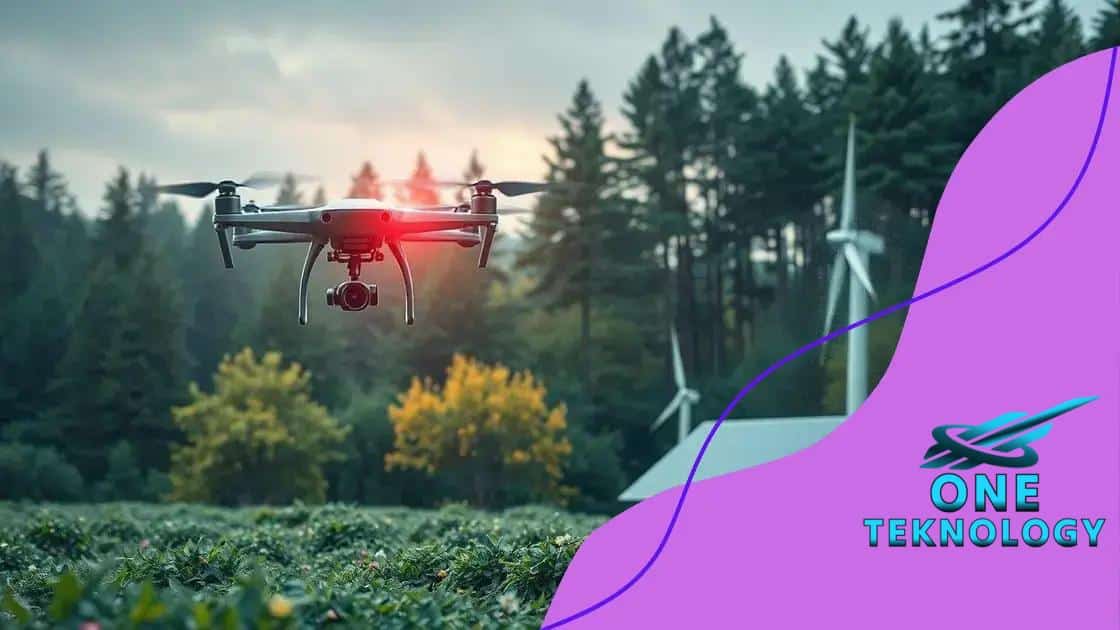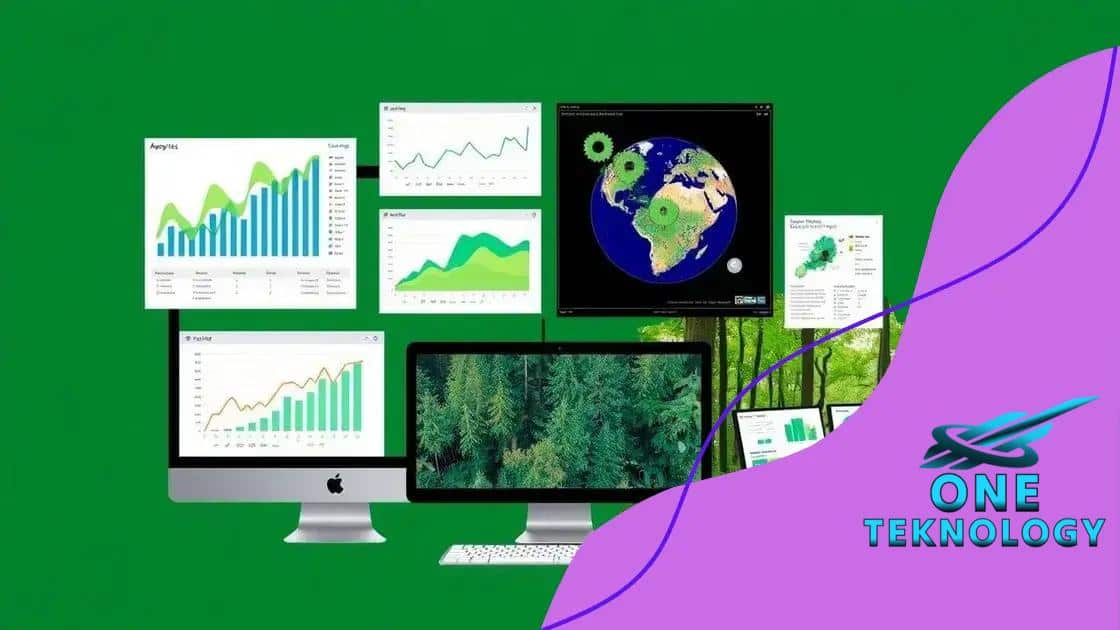How AI is helping in the fight against climate change

AI is helping in the fight against climate change by optimizing renewable energy, enhancing agricultural practices, and informing policies through data-driven insights, promoting a sustainable future.
How AI is helping in the fight against climate change signifies a significant shift in our battle for a sustainable planet. Curious about what innovative solutions are emerging? Let’s dive into how technology is reshaping our environmental efforts.
Understanding the role of AI in climate action
Understanding the role of AI in climate action is crucial as we navigate today’s environmental challenges. Many are unaware of how technology can significantly contribute to our efforts in fighting climate change.
AI’s Capabilities
Artificial Intelligence can process vast amounts of data quickly and accurately, making it an essential tool in climate science. It helps researchers identify trends and patterns that might be invisible to the human eye.
For instance, AI algorithms can analyze satellite imagery to monitor deforestation and urban expansion. This insight can promote more sustainable practices by informing policy decisions.
Benefits of Using AI
- Enhanced predictive modeling for climate phenomena.
- Improved energy efficiency in various industries.
- Innovative solutions for reducing carbon footprints.
- Real-time environmental monitoring and reporting.
These benefits illustrate how AI empowers different sectors, allowing for immediate responses to environmental issues. Many companies are already leveraging AI to optimize logistics and reduce waste.
The marriage of AI technology and environmental stewardship is paving the way for smarter energy solutions. For example, AI systems can optimize the use of renewable energy sources, ensuring that energy demand and production are in sync.
Real-World Applications
Many organizations have started using AI in creative ways to battle climate change. In agriculture, AI helps farmers determine the best planting times by analyzing weather forecasts and soil conditions.
Moreover, deployment of AI in smart grid technology enables utilities to efficiently manage electricity flows, resulting in reduced greenhouse gas emissions.
This synergy between AI and climate action demonstrates a remarkable potential for future innovations. As we continue to uncover how AI can assist in this fight, we realize that it is not merely a tool but a partner in creating a sustainable planet.
AI advancements in renewable energy
AI advancements in renewable energy are revolutionizing how we harness natural resources. With increasing energy demands, there’s a need for smarter solutions that can optimize energy production and consumption.
Improving Energy Efficiency
Artificial Intelligence plays a vital role in enhancing the efficiency of renewable energy systems. This technology can analyze vast datasets to predict energy output based on weather patterns.
For instance, wind turbines equipped with AI can adjust their blades in real time to capture more wind energy. This leads to higher energy production and reduced waste.
Smart Grids and Energy Management
- AI enables smart grids to balance supply and demand effectively.
- Real-time data helps in predicting outages and reducing management costs.
- Energy storage systems benefit from AI by optimizing when to charge and discharge.
- Consumers can also track their usage patterns and reduce waste.
The integration of AI in energy management empowers utility companies to forecast demand more accurately. This ensures that energy distribution is optimized and that renewable sources are maximized.
Additionally, AI algorithms help in identifying the best locations for solar farms or wind turbines. By analyzing geographical and meteorological data, companies can make informed decisions about where to invest.
Innovative Solutions in Solar Energy
In solar energy, AI techniques are being applied to enhance panel efficiency. By using machine learning, researchers can develop more effective solar cells that capture sunlight in diverse weather conditions.
AI also assists in maintaining solar panels by predicting when maintenance is needed. This proactive approach ensures panels operate at peak performance.
As we continue to explore AI advancements in renewable energy, it becomes clear that these innovations are essential for a sustainable future. The ability to analyze and respond to data in real time sets the stage for a cleaner and more efficient energy landscape.
Data analytics for environmental monitoring

Data analytics for environmental monitoring is reshaping how we understand our planet. By leveraging data, we can gain insights into various environmental factors that affect our health and climate.
The Power of Big Data
Big data refers to the massive volume of information gathered from sensors, satellites, and other sources. This data is crucial in monitoring the health of ecosystems and the impact of human activities.
For instance, air quality sensors can provide real-time data on pollution levels in urban areas. This information is vital for local governments to take immediate actions to improve air quality.
Applications of Data Analytics
- Tracking wildlife populations to assess ecosystem health.
- Monitoring deforestation and land-use changes through satellite imagery.
- Analyzing water quality data to prevent contamination.
- Predicting climate patterns to inform disaster preparedness.
These applications illustrate how data can be a powerful tool in identifying trends and making informed decisions. As data analytics continues to evolve, its role in environmental monitoring becomes increasingly significant.
Furthermore, data analytics can identify climate change impacts on agriculture. By using historical data, farmers can optimize their practices to adapt to changing weather conditions. Predictive analytics can also assist in resource management, ensuring that water and energy are used efficiently.
Future of Environmental Monitoring
As technology advances, the potential for improved data analytics in environmental monitoring grows. Machine learning algorithms can analyze complex datasets faster and more accurately than ever before.
The integration of AI and data analytics paves the way for innovative approaches to environmental challenges. For example, using drones for aerial surveys can provide insights into areas that are difficult to reach, enabling more comprehensive environmental assessments.
By continuing to invest in data analytics for environmental monitoring, we can enhance our understanding of the climate crisis and foster sustainable practices worldwide.
Case studies: AI in agriculture and forestry
Case studies of AI in agriculture and forestry highlight innovative solutions for tackling modern farming challenges. These examples show how technology is transforming traditional practices into more efficient and sustainable methods.
Precision Agriculture
One compelling case study involves precision agriculture, which uses AI to analyze data from various sources, including soil sensors and satellite imagery. For example, a farm in California utilized AI algorithms to optimize irrigation schedules.
This smart system analyzed soil moisture levels and weather forecasts, enabling the farmers to water their crops only when necessary. The result was a significant reduction in water usage and an increase in crop yield.
Crop Monitoring
- Drones equipped with AI technology help monitor crop health by capturing high-resolution images.
- Machine learning can predict pest infestations before they occur, allowing for timely interventions.
- Farmers in Brazil have successfully used AI to assess the health of coffee plants, increasing productivity.
Such applications illustrate how AI assists farmers in making better decisions based on data, leading to improved sustainability and economic viability.
In forestry, AI is also making waves. One study showed that AI can analyze satellite images to detect illegal logging activities in real time. This allows conservationists to respond swiftly and protect valuable forest resources.
Smart Forestry Techniques
Moreover, AI is being used to predict wildfire risks by analyzing various environmental factors. In Canada, a project utilized AI to assess vegetation data, predicting areas most likely to catch fire. By understanding these patterns, firefighters can allocate resources more effectively.
As more case studies emerge, it becomes clear that AI is revolutionizing agriculture and forestry. The combination of technology with traditional practices fosters greater resilience against climate change and promotes sustainable resource management.
Future implications of AI on climate policy
The future implications of AI on climate policy are vast and promising. As governments and organizations recognize the potential of AI, they are starting to integrate this technology into their climate strategies.
Data-Driven Decision Making
One of the key roles of AI in climate policy is enabling data-driven decision-making. By analyzing huge datasets, AI can identify trends and predict future climate scenarios, which helps policymakers understand the potential impacts of their actions.
For example, AI models can forecast the effects of carbon emission reductions on temperatures over time, allowing lawmakers to make informed decisions.
Enhanced Climate Models
- AI enhances climate models by integrating diverse data sources, including satellite observations and historical climate data.
- Machine learning algorithms can improve the accuracy of predictions for extreme weather events.
- Countries can better prepare for natural disasters by using AI-enhanced predictions.
- AI can support the development of climate resilience strategies in vulnerable regions.
These enhancements not only help with current challenges but also guide long-term climate policy development. As AI continues to evolve, its integration into climate policies will become even more critical.
Moreover, the use of AI can foster international cooperation on climate change. Through open data platforms and AI tools, countries can share information and strategies, working together to tackle global issues.
Green Technology Innovations
The advancement of green technologies, powered by AI, can also drive climate policy changes. Innovations such as smart energy management systems and autonomous vehicles can help reduce emissions.
As these technologies become mainstream, policies will need to adapt to promote their deployment while ensuring that environmental standards are met.
By anticipating the future implications of AI on climate policy, we can create a more sustainable world. The combination of artificial intelligence and strategic policymaking can facilitate significant progress towards achieving climate goals.
FAQ – Frequently Asked Questions about AI in Climate Change
How does AI optimize renewable energy use?
AI analyzes data to improve the efficiency of renewable energy sources, allowing for smarter management of resources.
What role does AI play in agriculture?
AI techniques enhance crop yields by providing insights for better farming practices, such as predicting weather and pest outbreaks.
Can AI help in forming climate policies?
Yes, AI supports policymakers by analyzing complex data and forecasting outcomes, leading to more informed and effective climate strategies.
What are the global implications of AI for climate action?
AI fosters international cooperation by offering shared tools and data to tackle climate challenges collectively.






